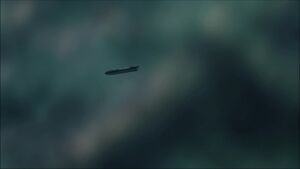Ragnar: Difference between revisions
More actions
Tense. Capitilzation |
m Robot: Automated text replacement (-Cylon agent +Humanoid Cylon) |
||
| Line 7: | Line 7: | ||
The storms themselves create a high level of electromagnetic interference in the upper atmosphere of the planet, which interferes with a range of systems - including a ship's ability to plot [[FTL]] jumps. While this effectively hides Ragnar Anchorage from enemy scans, it also means that a ship must cross the "EM threshold" above the main bulk of the atmosphere before attempting a jump. This problem requires [[William Adama|Commander Adama]] to place ''[[Galactica (RDM)|Galactica]]'' directly between the planet and an opposing force of Cylon [[Basestar (RDM)|basestars]] to provide the necessary protection for the civilian [[The Fleet (RDM)|Fleet]] to jump away from Colonial space. | The storms themselves create a high level of electromagnetic interference in the upper atmosphere of the planet, which interferes with a range of systems - including a ship's ability to plot [[FTL]] jumps. While this effectively hides Ragnar Anchorage from enemy scans, it also means that a ship must cross the "EM threshold" above the main bulk of the atmosphere before attempting a jump. This problem requires [[William Adama|Commander Adama]] to place ''[[Galactica (RDM)|Galactica]]'' directly between the planet and an opposing force of Cylon [[Basestar (RDM)|basestars]] to provide the necessary protection for the civilian [[The Fleet (RDM)|Fleet]] to jump away from Colonial space. | ||
Another side effect of the storm is the emission of a form of radiation that adversely affected Cylon technology - including [[Cylon | Another side effect of the storm is the emission of a form of radiation that adversely affected Cylon technology - including [[Humanoid Cylon]]s. It is possible, that the initial effects on Cylon technology became known to the Colonials during the [[Cylon War]], prompting them to place the Anchorage within the planet's atmosphere. When [[Leoben Conoy]] appeares to fall sick while trapped on the station with Adama, it gives the commander his first clue that Conoy is a Cylon construct - although at the time he most likely suspects Conoy to be a mechanical android rather than an almost exact organic replica of a human ([[Miniseries]]). | ||
==Notes== | ==Notes== | ||
Revision as of 14:53, 2 February 2007

Ragnar is a gas giant planet, and the location of the Ragnar Anchorage munitions station (Miniseries) located in the outer reaches of the Twelve Colonies.
The atmosphere of the planet, in keeping with some gas giants, is wracked by violent storms. Ragnar Anchorage station appears to be located in an area of relative calm within the very tenuous upper atmosphere, which may be the reverse of such phenomena as the Great Red Spot in the atmosphere of Jupiter.
The storms themselves create a high level of electromagnetic interference in the upper atmosphere of the planet, which interferes with a range of systems - including a ship's ability to plot FTL jumps. While this effectively hides Ragnar Anchorage from enemy scans, it also means that a ship must cross the "EM threshold" above the main bulk of the atmosphere before attempting a jump. This problem requires Commander Adama to place Galactica directly between the planet and an opposing force of Cylon basestars to provide the necessary protection for the civilian Fleet to jump away from Colonial space.
Another side effect of the storm is the emission of a form of radiation that adversely affected Cylon technology - including Humanoid Cylons. It is possible, that the initial effects on Cylon technology became known to the Colonials during the Cylon War, prompting them to place the Anchorage within the planet's atmosphere. When Leoben Conoy appeares to fall sick while trapped on the station with Adama, it gives the commander his first clue that Conoy is a Cylon construct - although at the time he most likely suspects Conoy to be a mechanical android rather than an almost exact organic replica of a human (Miniseries).
Notes
- The name of the planet is an allusion to the tale of Ragnarok, the apocalyptic battle of the gods of Norse mythology.
